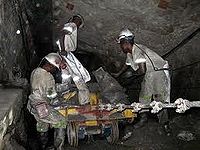Mining
Mining of elements began very early, probably since the dawn of human civilization. The period of the Copper Age, then the Bronze Age and the Iron Age are all testimony to the endeavor of humans to dig into the earth and extract minerals as and when they required. Since then mining has undergone a sea change but the basic process has more or less remained the same.
Ores recovered by mining include metals, coal and oil shale, gemstones, limestone, and dimension stone, rock salt and potash, gravel, and clay. Mining is required to obtain any material that cannot be grown through agricultural processes, or created artificially in a laboratory or factory. Mining in a wider sense includes extraction of any non-renewable resource such as petroleum, natural gas, or even water.
Mining of stone and metal has been done since pre-historic times. Modern mining processes involve prospecting for ore bodies, analysis of the profit potential of a proposed mine, extraction of the desired materials, and final reclamation of the land after the mine is closed.
The nature of mining processes creates a potential negative impact on the environment both during the mining operations and for years after the mine is closed. This impact has led to most of the world's nations adopting regulations to moderate the negative effects of mining operations. Safety has long been a concern as well, and modern practices have improved safety in mines significantly.
Types
Strip mining process
as the name suggests the surface of the earth is stripped. In this process the soil and rocks that lie above is removed generally by heavy machinery and then the material is extracted. This type is possible only when the targeted materials are relatively near the surface. The mineral generally extracted is coal or some kinds of sedimentary rocks.
Placer mining process
in this process alluvial deposits in sand or gravel are extracted. This process does not involve the usage of any sort of heavy materials and can be considered relatively easy when compared to others. Generally gold and other gemstones are mined in this process.
Mountain top process
this process involves blasting of the top of mountains expose the coal below it. This process is relatively new.
Hydraulic mining process
in this process high pressure water jets are used to dislodge rocks and minerals. During earlier times gold was found in an easier way by this method. However, this process has been discontinued due to environmental concerns.
Dredging process
it is the process of underwater excavation by deepening a water body. In this method sediments and other substances are removed from harbors, rivers and other water bodies and minerals are extracted.
Open pit process
the easiest and the cheapest way to mine materials that are close to the surface, large open holes are dug in the ground. Sometimes, explosives are used to get large blocks of rocks out of the way.
Effect to the Environment
Mining is generally very destructive to the environment. It is one of the main causes of deforestation. In order to mine, trees and vegetation are cleared and burned. With the ground completely bare, large scale mining operations use huge bulldozers and excavators to extract the metals and minerals from the soil. In order to amalgamate (cluster) the extractions, they use chemicals such as cyanide, mercury, or methylmercury. These chemicals go through tailings (pipes) and are often discharged into rivers, streams, bays, and oceans. This pollution contaminates all living organisms within the body of water and ultimately the people who depend on the fish for their main source of protein and their economic livelihood.
Small scale mining is equally devastating to the environment, if not more. Groups of 5-6 men migrate from one mining site to another in search of precious metals, usually gold. There are two types of small scale mining: land dredging and river dredging:
Land dredging involves miners using a generator to dig a large hole in the ground. They use a high pressure hose to expose the gold-bearing layer of sand and clay. The gold bearing slurry is pumped into a sluice box, which collects gold particles, while mine tailings flow into either an abandoned mining pit or adjacent forest. When the mining pits fill with water from the tailings, they become stagnant water pools. These pools create a breeding ground for mosquitoes and other water-born insects. Malaria and other water-born diseases increase significantly whenever open pools of water are nearby.
River dredging involves moving along a river on a platform or boat. The miners use a hydrolic suction hose and suction the gravel and mud as they move along the river. The gravel, mud, and rocks go through the tailings (pipes) and any gold fragments are collected on felt mats. The remaining gravel, mud, and rocks go back into the river, but in a different location than where it was originally suctioned. This creates problems for the river. The displaced gravel and mud disrupt the natural flow of the river. Fish and other living organisms often die and fishermen can no longer navigate in the obstructed rivers.
Videos
